Test Images
This page shows a number of test images made with the custom fused-silica zoom lens. All the images here were taken with a fully-modified Nikon D90 in Raw 12-bit/channel mode. They have been re-sized and down-converted to 24 bits per pixel but not otherwise modified unless stated otherwise. All in-camera sharpening was turned off. The exposure mode and focusing were set to Manual. For the visible-light photos with the Nikkor, autofocus was used.
Fig. 1 Visible light image of purple flowers
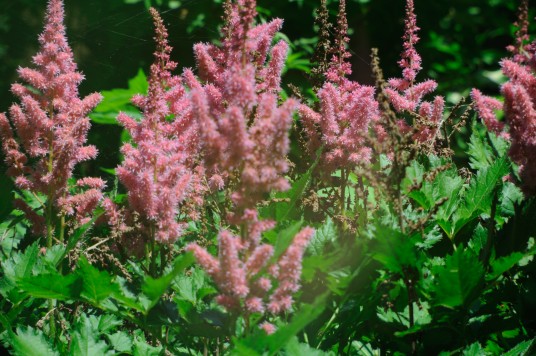
Fig. 1. Visible light image of purple Astilbe flowers photographed with custom fused silica lens
Even though the fused-silica lens was designed for UV, it was also good for visible wavelengths. Compare this photo with Fig. 2 below, which was taken with a Nikkor 80-200 zoom lens. Both photos appear equally sharp, but of course I'm cheating a little here: you would probably not notice spherical aberration in a scene like this unless it was quite pronounced. Not much chromatic aberration or fall-off are visible, either.
All the photos on this page taken with the custom lens have a bright area near the center. This is due to the fact that I used uncoated lens elements. That is turning out to be a mistake.
| Lens | Fused silica custom | Focus mode | Manual |
| Date | 06/30/2013 | Time | 10:57 am |
| Aperture | Shutter speed | 1/200 | |
| Focal length | 100 mm | ISO | 200 |
| Filter | UV/IR block | Distance | 2 meters |
If viewing on a cell phone, drag table left or right to scroll.
Fig. 2 The same scene photographed with a Nikkor 80-200 2.8D zoom lens.
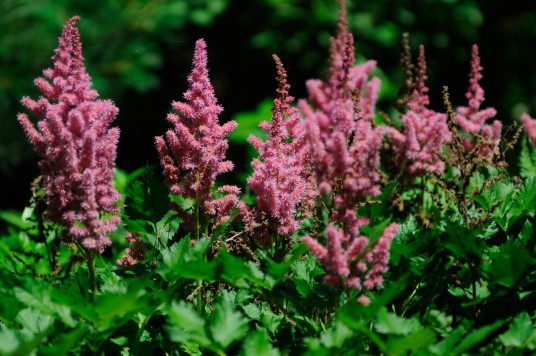
Fig. 2. Visible light photo of purple flowers photographed with a Nikkor 80-200 2.8D.
The brighter colors in this image compared to Fig. 1 are caused by the slightly different exposures, and are not due to differences in the lenses.
| Lens left | Fused silica custom | Focus mode | Manual |
| Lens | Nikkor 80-200 f/2.8D | Focus mode | Auto |
| Date | 06/30/2013 | Time | 11:07 am |
| Aperture | f/2.8 | Shutter speed | 1/4000 |
| Focal length | 80 mm | ISO | 200 |
| Filter | None | Distance | 2 meters |
If viewing on a cell phone, drag table left or right to scroll.
Fig. 3 Full-size crops (1.56% total area) from the centers of the above images.
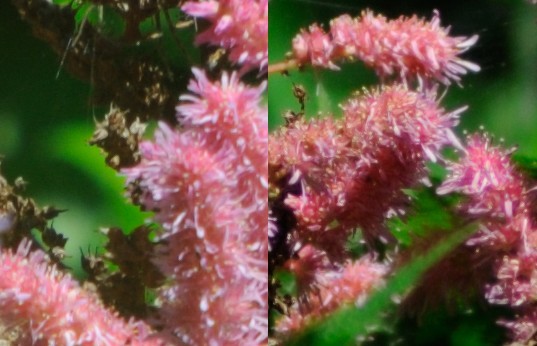
Fig. 3. In the center, both lenses are reasonably sharp, although it's not easy to tell because of the narrow depth of field. The fused silica lens (left) appears a little less contrasty. Part of this may be due to the constantly shifting lighting conditions.
Fig. 4 Full-size crops from the corners.
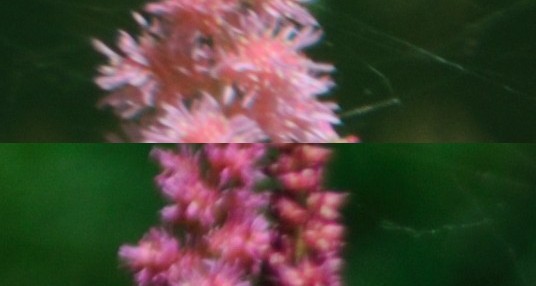
Fig. 4. In the corners, the fused silica lens (top) was slightly sharper, which made the spider web strands easier to see, but it also showed a trace of chromatic aberration which was not present in the Nikkor. Unlike with a simple quartz lens, which had bad chromatic aberration, the CA was not easy to see unless the image is shown full-size.
Fig. 5 The same purple flowers photographed using an ultraviolet filter.
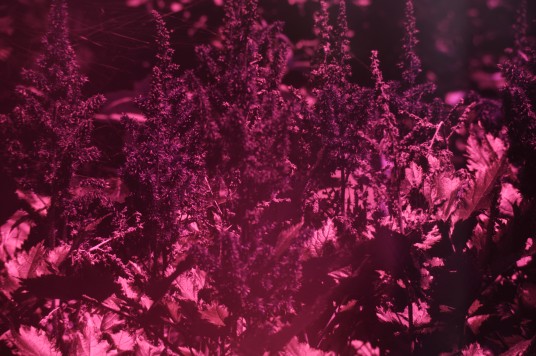
Fig. 5. UV photo of purple flowers - Fused silica lens
These purple flowers appear uniformly dark in ultraviolet light, looking more like tobacco plants than flowers. Even so, there are always bees around these flowers. This photo challenges the myth that bees require a “target” pattern in ultraviolet light in order to find the flower.
This image also shows a particularly bad example of an internal reflection in the lens. This is caused by my use of uncoated lens elements, which is turning out to have been a mistake. The reflections were eliminated when I added an iris diaphragm.
| Lens | Fused silica custom | Focus mode | Manual |
| Date | 06/30/2013 | Time | 11:00 am |
| Shutter speed | 2 sec | Aperture | |
| ISO | 200 | Focal length | |
| Distance | 2 meters | Filter | Baader U filter |
If viewing on a cell phone, drag table left or right to scroll.
Fig. 6 The same scene photographed with a Nikkor 80-200 f/2.8D zoom lens set to the same focal length.
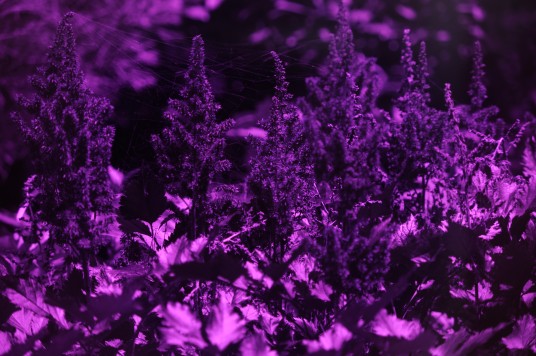
Fig. 6. UV photo of purple flowers – Nikkor 80-200 f/2.8D lens
This photo appears bluer than the previous image because less of the shorter UV wavelengths are getting through the glass Nikkor lens. Because of peculiarities of the red and blue pigments on the camera's sensor, the shortest UV wavelengths appear red and the longest infrared wavelengths appear blue—the opposite of what you would expect.
| Lens | Nikkor 80-200 f/2.8D | Focus mode | Manual |
| Date | 06/30/2013 | Time | 11:09 am |
| Shutter speed | 4 sec | Aperture | f/4 |
| ISO | 200 | Focal length | 80 mm |
| Distance | 2 meters | Filter | Baader U filter |
If viewing on a cell phone, drag table left or right to scroll.
Fig. 7 Infrared, visible, and UV photo of white lilies taken with the custom silica lens.
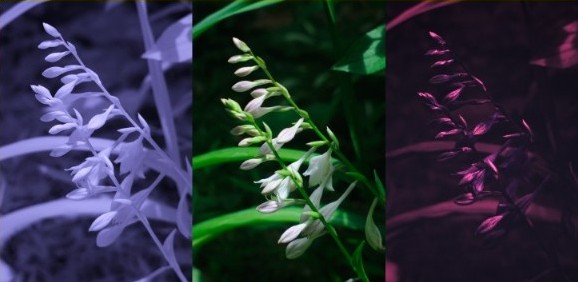
Fig. 7. Infrared, visible, and UV photo of white lilies photographed with a custom fused silica lens (cropped and resized)
This is another example of how not all flowers have a dark center in the ultraviolet. In fact, the entire flower is dark, yet bees have no problem finding them. Neither do deer.
| Lens | Fused silica custom | Focus mode | Manual |
| Date | 07/06/2013 | Time | 12:17 pm |
| Shutter speed (left) | 1/200 sec | Shutter speed (center) | 1/200 sec |
| Shutter speed (right) | 1/2 sec | Aperture | |
| ISO | 200 | Focal length | 80 mm |
| Distance | 1.5 meters | Filter (left) | X-Nite BPG |
| Filter (center) | UV/IR block | Filter (right) | Baader U |
If viewing on a cell phone, drag table left or right to scroll.
Fig. 8 Larger version.
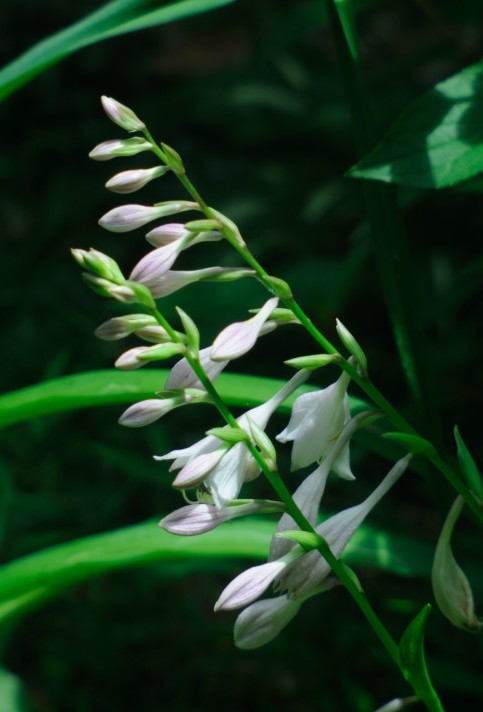
Fig. 8. Larger version of the visible photo of white lilies taken with the custom silica lens (cropped and resized).
A closer view shows that the image is quite contrasty, with no detectable halo, which indicates that spherical aberration is under control. This lens also seems to have a pretty nice bokeh, probably due to the fact that there is no iris diaphragm.
| Lens | Fused silica custom | Focus mode | Manual |
| Date | 07/06/2013 | Time | 12:07 pm |
| Shutter speed | 1/200 sec | Aperture | |
| ISO | 200 | Focal length | 80 mm |
| Distance | 1.5 meters | Filter | UV/IR block |
If viewing on a cell phone, drag table left or right to scroll.
Fig. 9 UV photo of ivy leaves.
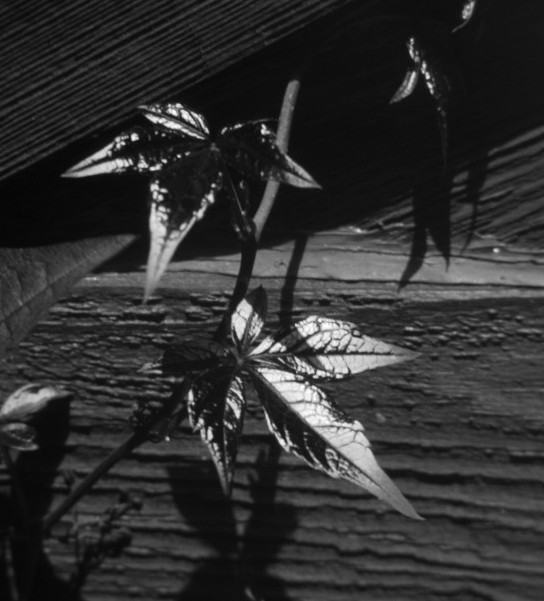
Fig. 9. UV photo of ivy leaves (identified by an alert reader as Virginia creeper) photographed with a custom fused silica lens. Many plant leaves that appear shiny in the visible appear almost metallic in ultraviolet light. I am still hoping to find some poison ivy, which has particularly shiny leaves. We had lots of it back east. If weather permits, I'll go back and grab a bunch. (Photo converted to grayscale, cropped, and resized).
| Lens | Fused silica custom | Focus mode | Manual |
| Date | 07/06/2013 | Time | 12:17 pm |
| Shutter speed | 1/2 sec | Aperture | |
| ISO | 200 | Focal length | |
| Distance | 1 meter | Filter | Baader U filter |
If viewing on a cell phone, drag table left or right to scroll.
Fig. 10 UV photo of some weeds.
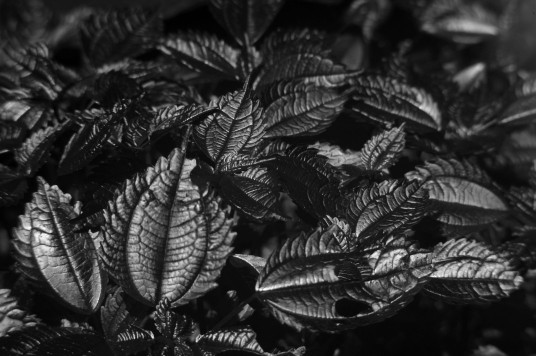
Fig. 10. UV photo of weeds that I forgot to trim, showing metallic appearance in the ultraviolet.
| Lens | Nikkor 80-200 f/2.8D | Focus mode | Manual |
| Date | 07/06/2013 | Time | 11:47 am |
| Shutter speed | 1/5 sec | Aperture | |
| ISO | 200 | Focal length | 100 mm |
| Distance | 1 meter | Filter | Baader U filter |
If viewing on a cell phone, drag table left or right to scroll.
Fig. 11 Tiger lilies in visible and ultraviolet.
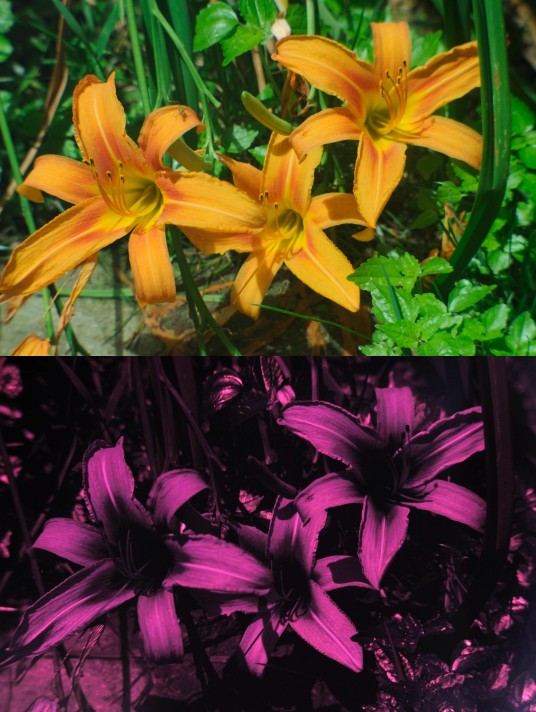
Fig. 11. UV photo of tiger lilies photographed with a custom fused silica lens in visible light (top) and ultraviolet light (bottom). Tiger lily flowers close up at night (a phenomenon known as nyctinasty) and re-open in the daytime. In ultraviolet light, the center part of the Tiger Lily is darker than the edges—the opposite of how it appears in visible light. Some other flowers, such as dandelions, also show this effect. But many flowers are uniformly dark when photographed in ultraviolet light, which casts doubt on the popular myth that the dark center is a visual cue for bees.
| Lens | Fused silica custom | Focus mode | Manual |
| Date | 07/06/2013 | Time | 11:40 am |
| Shutter speed (top) | 1/400 sec | Shutter speed (bottom) | 1/20 sec |
| Aperture | ISO | 200 | |
| Focal length | 80 mm | Distance | 1 meter |
| Filter (top) | UV/IR block | Filter (bottom) | Baader U filter |
If viewing on a cell phone, drag table left or right to scroll.
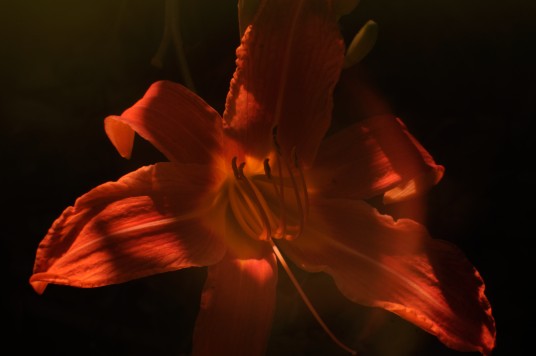
Another photo of tiger lily in visible light
Fig. 12 Daisies in visible and ultraviolet.
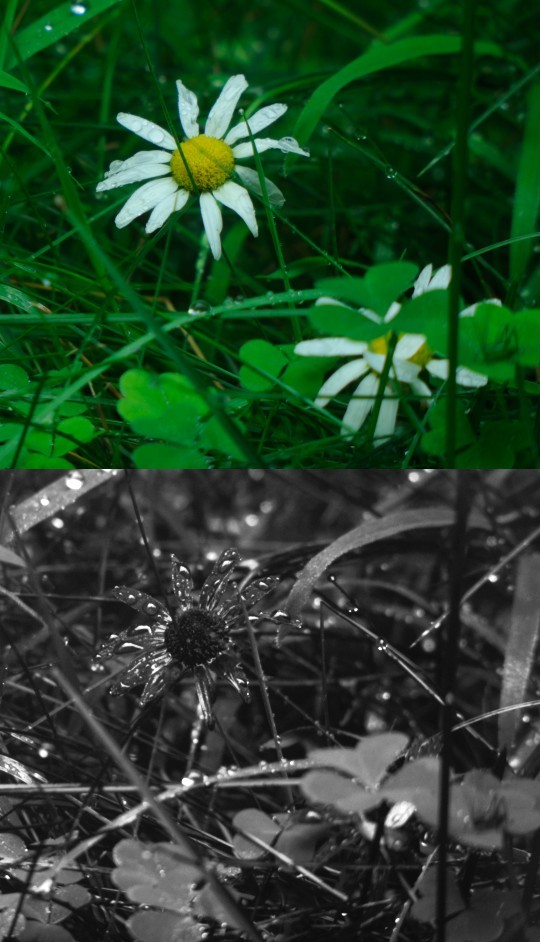
Fig. 12. If any flower would have a center that is dark in the UV, you would think it would be a daisy, with its yellow center and white petals. But daisies are uniformly dark in ultraviolet light.
| Lens | Fused silica custom | Focus mode | Manual |
| Date | 07/13/2013 | Time | 09:35 am |
| Shutter speed (top) | 1/100 sec | Shutter speed (bottom) | 2 sec |
| Aperture | ISO | 200 | |
| Focal length | 80 mm | Distance | 0.5 meters |
| Filter (top) | UV/IR block | Filter (bottom) | Baader U filter |
If viewing on a cell phone, drag table left or right to scroll.
Fig. 13 Infrared photo of trees using XNite BPR infrared filter.
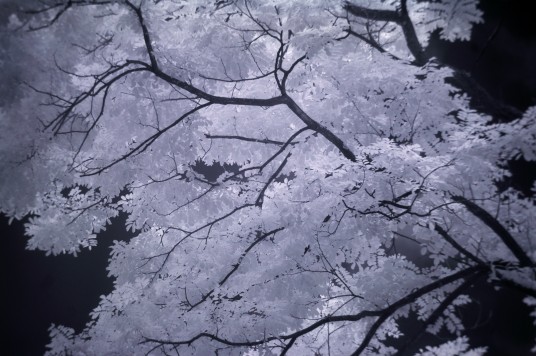
Fig. 13. The lens also worked in the infrared, as shown by this image of oak tree leaves. The BPR filter only transmits light between 889 and 977 nm (10%T cutoff), which is close to the long wavelength limit of the silicon sensor. This image was not color-swapped. It appears blue because at these wavelengths, the blue pigment on the sensor actually transmits as much light as the red pigment. The mostly clear sky appears dark blue through the leaves.
This image also shows a certain amount of misfocus in the corners, caused by field curvature. Stopping down the lens reduced it somewhat. The field curvature was greater for subjects that were far away. According to Smith [1], field curvature is strongly influenced by the position of the aperture stop. So something will have to be adjusted on the zoom mechanism.
| Lens | Fused silica custom | Focus mode | Manual |
| Date | 07/13/2013 | Time | 8:43 am |
| Shutter speed | 1/10 sec | Aperture | |
| ISO | 200 | Focal length | 80 mm |
| Distance | 30 meters | Filter | XNite BPR |
If viewing on a cell phone, drag table left or right to scroll.
Fig. 14 Rhododendron
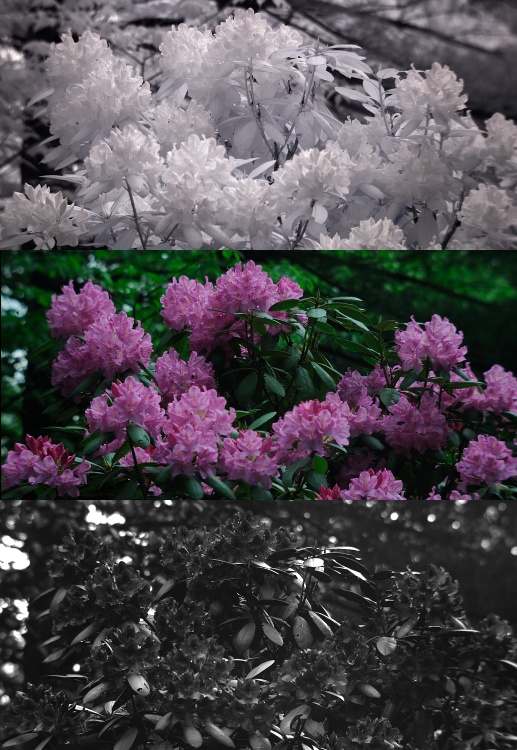
Fig. 14. Infrared, visible, and UV photo of flowering rhododendron bush. All flowers and leaves, regardless of color, are white in infrared. But despite the pink or violet color, rhododendron flowers are so dark in the ultraviolet they are almost invisible. Even so, they are always surrounded by bees, casting further doubt on the bees-attracted-to-UV theory.
| Lens | Fused silica custom | Focus mode | Manual |
| Date | 05/17/2014 | Time | 10:27 am |
| Shutter speed (top) | 1/320 sec | Filter (top) | R72 |
| Shutter speed (center) | 1/125 sec | Filter (center) | UV/IR block |
| Shutter speed (bottom) | 1 sec | Filter (bottom) | Baader U |
| Aperture | ISO | 200 | |
| Focal length | 80 mm | Distance | 2 meters |
If viewing on a cell phone, drag table left or right to scroll.
Fig. 15 Goldenrod
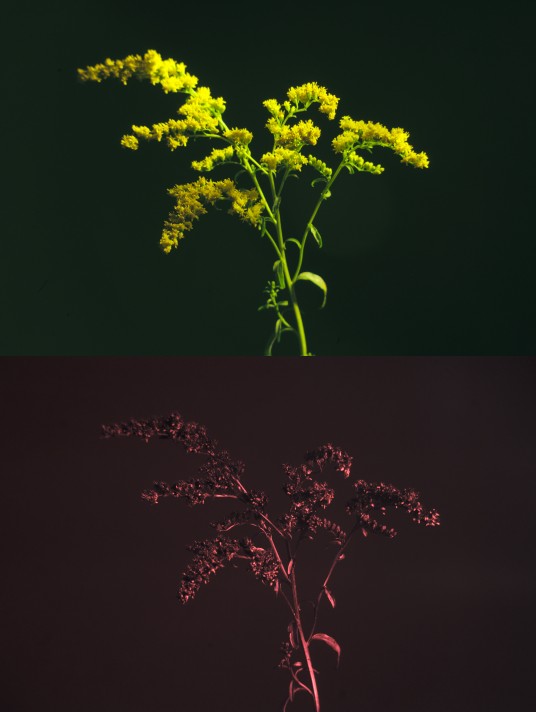
Fig. 15. You might expect a goldenrod, with its bright yellow color, to be dark in the UV, and you would be right. Goldenrod are highly camouflaged in the ultraviolet. They are so dark in the UV that I had to clamp this specimen in a vise in my ... er ... studio, shine a UV light on it, and take a time exposure before it would show up in the photo. Even then, I had to brighten the image by raising the gamma so the flower would be visible against the black background.
Goldenrod is sometimes mistakenly believed to cause hay fever, but this is a myth.
I should mention that the goldenrod did not seem to like being clamped in a vise and blasted with ultraviolet radiation. It turned brown a couple of hours after this picture was taken.
| Lens | Fused silica custom | Focus mode | Manual |
| Date | 07/20/2013 | Time | 08:29 am |
| Shutter speed (top) | 1/20 sec | Shutter speed (bottom) | 10 sec |
| Aperture | ISO | 200 | |
| Focal length | 80 mm | Distance | 1.5 meters |
| Filter (top) | UV/IR block | Filter (bottom) | Baader U filter |
If viewing on a cell phone, drag table left or right to scroll.
Fig. 16 Wild carrot flower
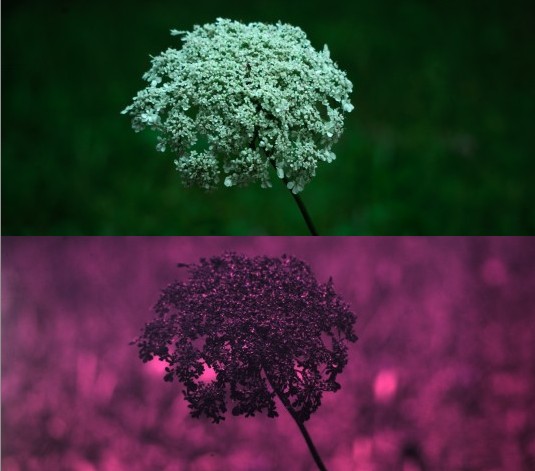
Fig. 16. Most flowers that have small petals are dark in the ultraviolet. This is a common white flower, known as Daucus carota (wild carrot or Queen Anne's Lace), which grows wild by the side of the road. Its appearance is very similar to poison hemlock. This particular specimen had several thyreocorids on it, which I removed before taking the picture.
| Lens | Fused silica custom | Focus mode | Manual |
| Date | 07/20/2013 | Time | 10:02 am |
| Shutter speed (top) | 1/200 sec | Shutter speed (bottom) | 2 sec |
| Aperture | ISO | 200 | |
| Focal length | 80 mm | Distance | 1.5 meters |
| Filter (top) | UV/IR block | Filter (bottom) | Baader U filter |
If viewing on a cell phone, drag table left or right to scroll.
Fig. 17 Chickory flower
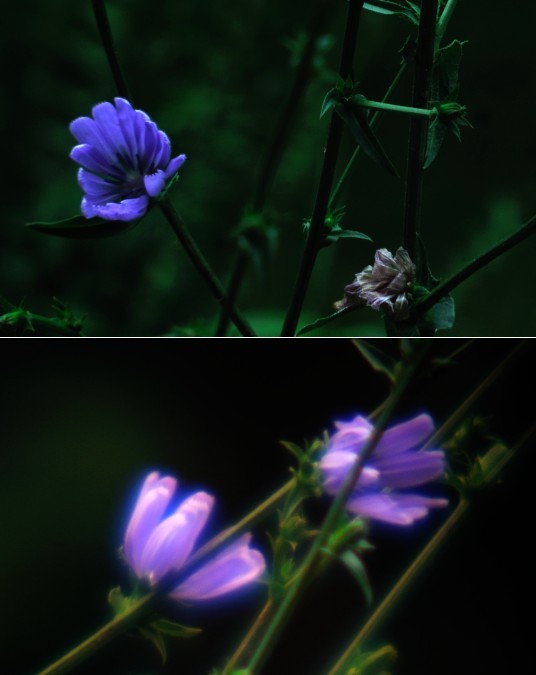
Fig. 17. This image was an experiment to help figure out why the edges of some of the images appeared slightly out of focus. These are crops of images of a blue Chickory flower I found growing by the road near the end of my driveway. The top image was made with the lens containing a CaF2 triplet. The bottom image was from an earlier lens made from 2 inch diameter 200 mm fused silica meniscus and a 1-inch 150 mm meniscus. In the lower panel, the flower and stem are much less sharp, and the bright areas have a blue halo due to optical aberrations. Even so, the lower image was equally sharp (or equally blurry) from edge to edge. The lower image is also brighter because of the bigger lens diameter. These photos proved that the problem with the top lens was not spherical aberration, but field curvature. It seems that it may be possible to reduce field curvature by making the front elements bigger than the rear elements.
| Lens (top) | Fused silica custom | Lens (bottom) | Fused silica custom, 2 inch, no triplet |
| Date | 07/20/2013 | Time | 7:05 am |
| Shutter speed (top) | 1/20 sec | Shutter speed (bottom) | 1/100 sec |
| Aperture (top) | Aperture (bottom) | f/7.16 | |
| ISO | 200 | Distance | 1.5 meters |
| Filter (top) | UV/IR block | Filter (bottom) | UV/IR block |
If viewing on a cell phone, drag table left or right to scroll.
Fig. 18 Chickory flower in UV
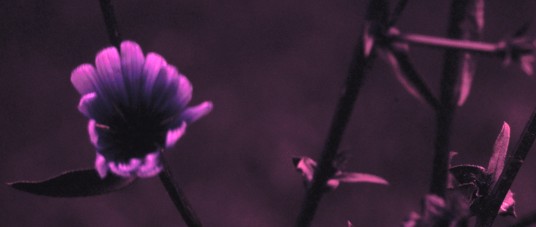
Fig. 18. In the UV, this blue Chickory flower was very dark in the center. (cropped)
| Lens | Fused silica custom | Focus mode | Manual |
| Date | 07/20/2013 | Time | 7:23 am |
| Shutter speed | 6 sec | Aperture | |
| ISO | 200 | Focal length | 80 mm |
| Distance | 1.5 meters | Filter | Baader U |
If viewing on a cell phone, drag table left or right to scroll.
Fig. 19 Black-eyed Susan
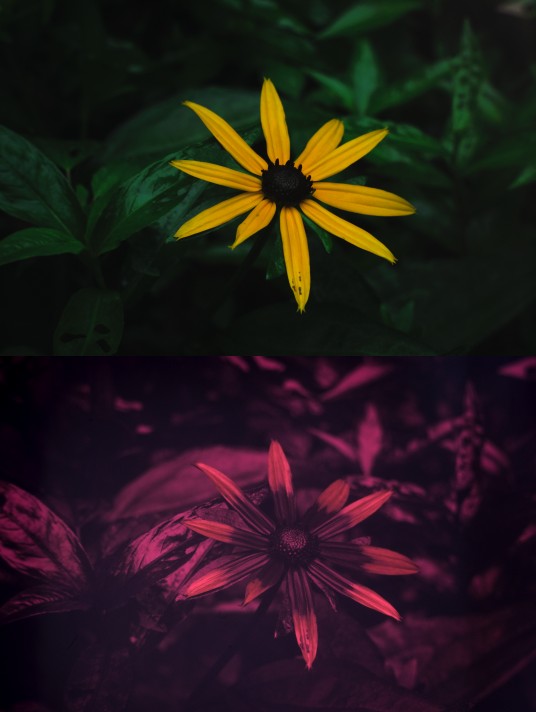
Fig. 19. Since daisies appear black in ultraviolet, there's no point in looking at a black-eyed susan, right? Wrong. The petals of a black-eyed susan (Rudbeckia hirta) are actually lighter than those of a daisy in the UV, and are two-toned: the 1959 Ford Galaxie of flowers.
| Lens | Fused silica custom | Focus mode | Manual |
| Date | 07/20/2013 | Time | 5:25 pm |
| Shutter speed (top) | 1/200 sec | Shutter speed (bottom) | 2 sec |
| Aperture | ISO | 200 | |
| Focal length | 80 mm | Distance | 0.7 meter |
| Filter (top) | UV/IR block | Filter (bottom) | Baader U filter |
If viewing on a cell phone, drag table left or right to scroll.
Fig. 20 Black-eyed susan in shortwave UV
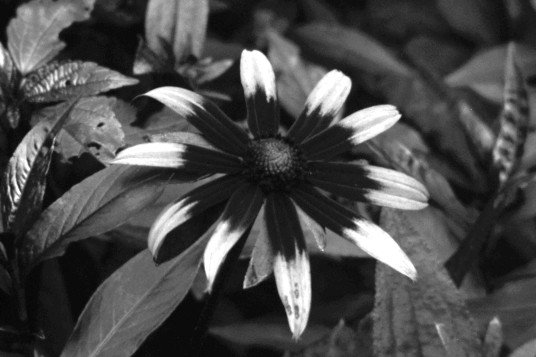
Fig. 20. At shorter wavelengths, the two-toned pattern is even more pronounced. (cropped and converted to grayscale)
| Lens | Fused silica custom | Focus mode | Manual |
| Date | 07/24/2013 | Time | 5:18 pm |
| Shutter speed | 0.5 sec | Aperture | |
| ISO | 200 | Focal length | 80 mm |
| Distance | 1.0 meters | Filter | Baader U |
If viewing on a cell phone, drag table left or right to scroll.
Fig. 21 Leaf trichomes
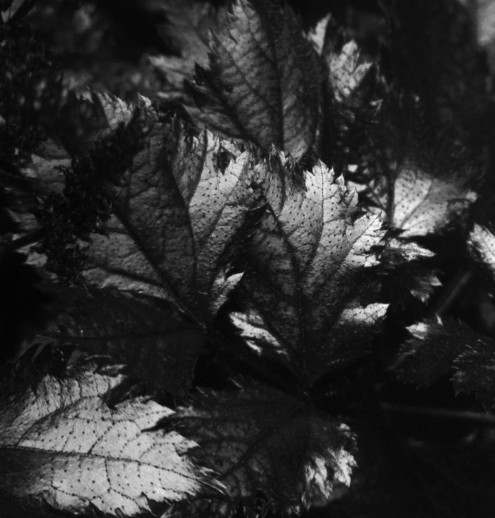
Fig. 21. UV enhances details like the hairy trichomes of certain leaves, which are barely visible in a regular camera.
| Lens | Fused silica custom | Focus mode | Manual |
| Date | 07/20/2013 | Time | 5:29 pm |
| Shutter speed | 2 sec | Aperture | |
| ISO | 200 | Focal length | 80 mm |
| Distance | 0.5 meter | Filter | Baader U filter |
If viewing on a cell phone, drag table left or right to scroll.
Fig. 22 Weeds
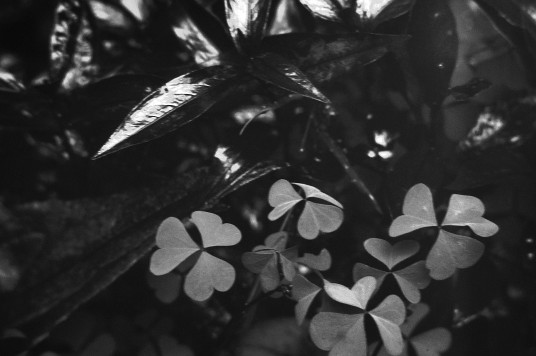
Fig. 22. Another UV photo of some more weeds in my back yard, showing metallic and non-metallic appearance of different species.
| Lens | Fused silica custom | Focus mode | Manual |
| Date | 07/20/2013 | Time | 5:57 pm |
| Shutter speed | 2 sec | Aperture | |
| ISO | 200 | Focal length | 80 mm |
| Distance | 0.5 meters | Filter | Baader U |
If viewing on a cell phone, drag table left or right to scroll.
Fig. 23 Dogwood Tree Flowers
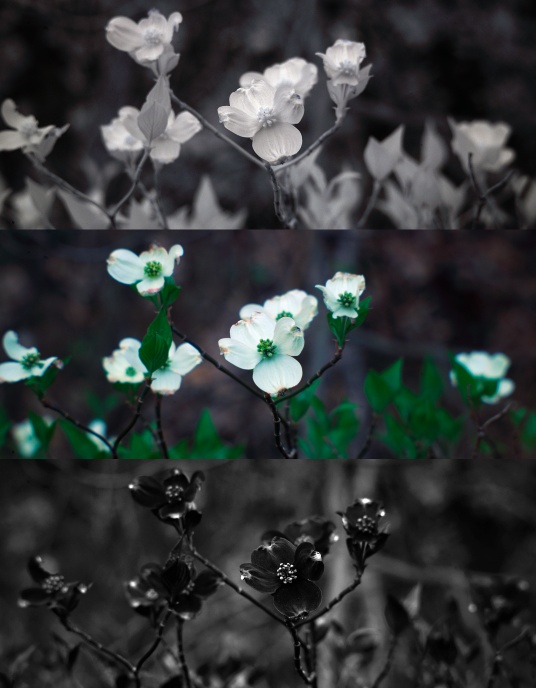
Fig. 23. This composite photo (top = infrared, middle = visible, bottom = ultraviolet) once again shows that flowers and leaves always appear white in infrared. Unexpectedly, however, even though the dogwood tree flowers appear pure white to the eye, they absorb ultraviolet light strongly, and appear velvety black in UV.
| Lens | Fused silica custom | Focus mode | Manual |
| Date | 04/27/2014 | Time | 6:30 am |
| Infrared speed | 1/40 sec | ISO | 200 |
| Visible speed | 1/40 sec | Distance | 0.5 meters |
| UV speed | 3 sec | IR Filter | R72 |
| Visible filter | UV/IR block | UV Filter | Baader U |
If viewing on a cell phone, drag table left or right to scroll.
Fig. 24 Plum Tree Flowers
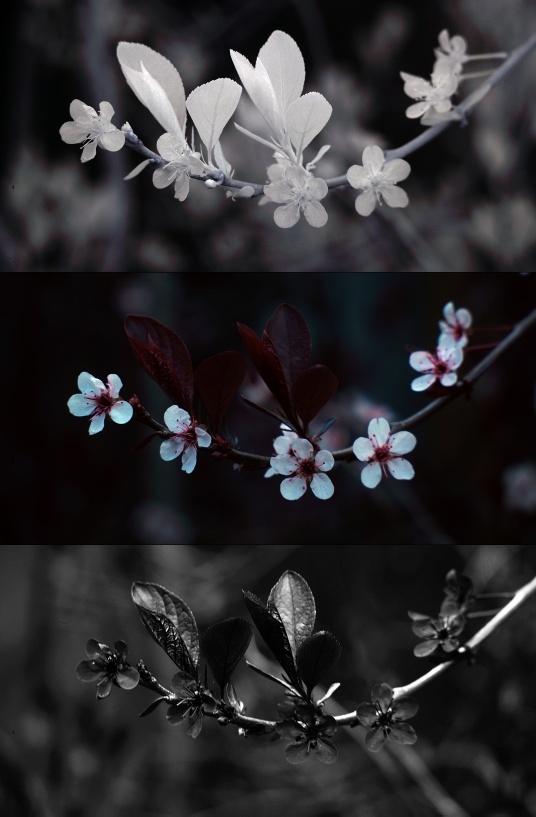
Fig. 24. Plum tree leaves appear deep red to the eye, but appear white in infrared and black in ultraviolet. Plum tree flowers also absorb ultraviolet light strongly, and appear black in UV, but not as dark as dogwood tree flowers.
| Lens | Fused silica custom | Focus mode | Manual |
| Date | 04/27/2014 | Time | 6:48 am |
| Infrared speed | 1/50 sec | ISO | 200 |
| Visible speed | 1/50 sec | Distance | 0.5 meters |
| UV speed | 3 sec | IR Filter | R72 |
| Visible filter | UV/IR block | UV Filter | Baader U |
If viewing on a cell phone, drag table left or right to scroll.
Fig. 25 Dandelions in visible and ultraviolet.
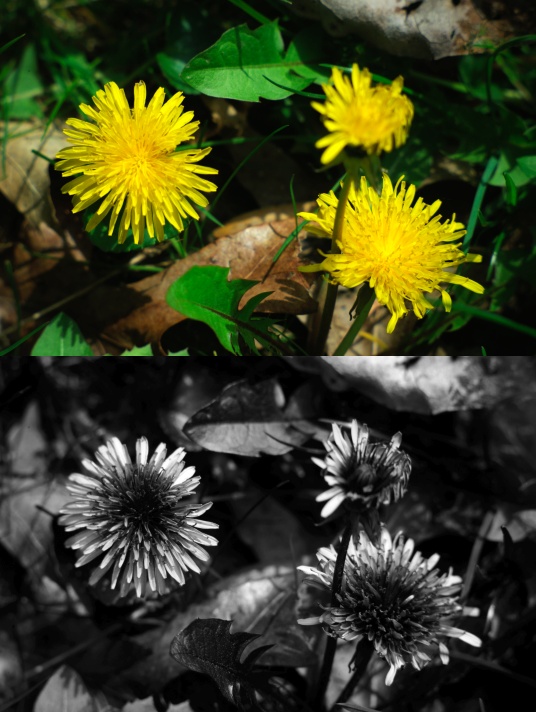
Fig. 25. Dandelions have a dark center in the ultraviolet.
| Lens | Fused silica custom | Focus mode | Manual |
| Date | 05/03/2014 | Time | 01:10 pm |
| Shutter speed (top) | 1/1000 sec | Shutter speed (bottom) | 1/4 sec |
| Aperture | ISO | 200 | |
| Focal length | 80 mm | Distance | 0.5 meters |
| Filter (top) | UV/IR block | Filter (bottom) | Baader U filter |
If viewing on a cell phone, drag table left or right to scroll.
Fig. 26 Dogwood flower in the UV
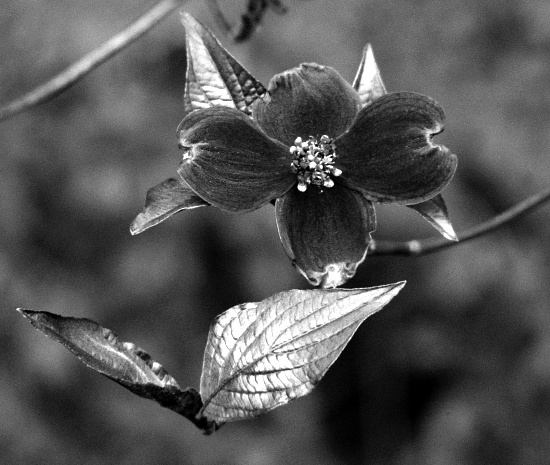
Fig. 26. Another UV photo of a flowering dogwood tree. In the visible, the center part is green and the petals are pure white. In the ultraviolet, the center part is white and the petals are black. The leaves also appear almost metallic. (Cropped)
| Lens | Fused silica custom | Focus mode | Manual |
| Date | 05/02/2014 | Time | 6:05 pm |
| Shutter speed | 3 sec | Aperture | |
| ISO | 1600 | Focal length | 80 mm |
| Distance | 1.0 meters | Filter | Baader U |
If viewing on a cell phone, drag table left or right to scroll.
Fig. 27 Pink wild flower in visible and ultraviolet.
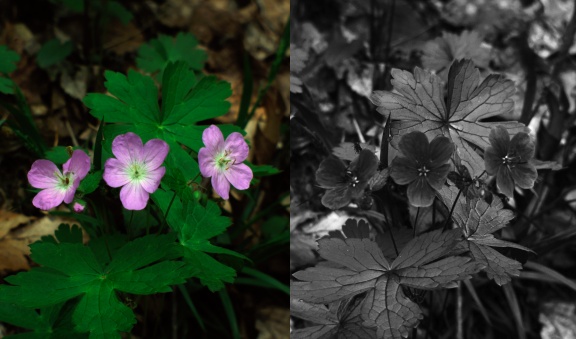
Fig. 27. Visible and UV photo of an unidentified pink wildflower. The flower appears black in ultraviolet, and the veining of the leaves is more clearly visible.
| Lens | Fused silica custom | Focus mode | Manual |
| Date | 05/09/2014 | Time | 05:54 pm |
| Shutter speed (left) | 1/125 sec | Shutter speed (right) | 1.3 sec |
| Aperture | ISO | 200 | |
| Focal length | 80 mm | Distance | 0.5 meters |
| Filter (left) | UV/IR block | Filter (right) | Baader U filter |
If viewing on a cell phone, drag table left or right to scroll.
Fig. 28 Ultraviolet photo of a buttercup.
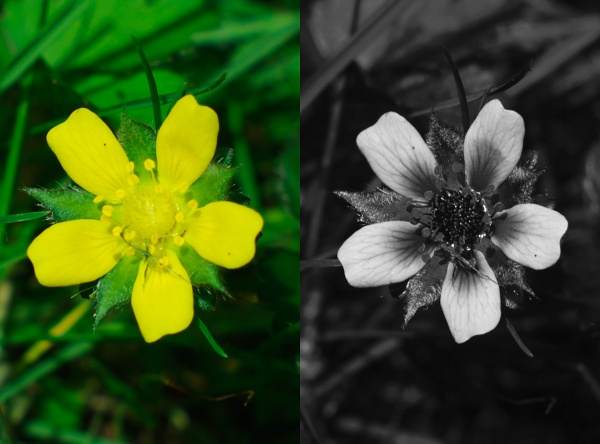
Fig. 28. Visible and UV photo of a buttercup. Buttercups are two-toned, like black-eyed susans, and have a dark center in ultraviolet light. The outer part of the petals is highly reflective in UV, and the faint green veins are more clearly visible. If you hold a buttercup next to the chin, a yellow reflection indicates that you, like the buttercup itself, are highly reflective to ultraviolet radiation.
| Lens | Fused silica custom | Focus mode | Manual |
| Date | 05/11/2014 | Time | 12:57 pm |
| Shutter speed (left) | 1/400 sec | Shutter speed (right) | 1/4 sec |
| Aperture | ISO | 200 | |
| Focal length | 80 mm | Distance | 0.3 meters |
| Filter (left) | UV/IR block | Filter (right) | Baader U filter |
If viewing on a cell phone, drag table left or right to scroll.
Fig. 29 Ultraviolet photo of henbit.
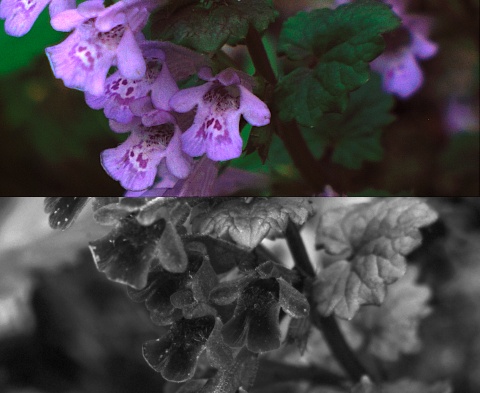
Fig. 29. Visible and UV photo of henbit flowers. Henbits are very small (7 mm diameter), purple flowers that grow like weeds. Their petals have distinctive spotted pattern. You might think that, because it's violet, this pattern would be even more prominent in the UV, but in fact it's not visible at all. The flower is pitch black in ultraviolet light. It's so dark that I had to illuminate it with a 365 nm flashlight in this photo before any details could be seen.
| Lens | Fused silica custom | Focus mode | Manual |
| Date | 05/11/2014 | Time | 07:07 pm |
| Shutter speed (top) | 1/100 sec | Shutter speed (bottom) | 2 sec (illuminated) |
| Aperture | ISO | 200 | |
| Focal length | 80 mm | Distance | 0.12 meters |
| Filter (top) | UV/IR block | Filter (bottom) | Baader U filter |
If viewing on a cell phone, drag table left or right to scroll.
Fig. 30 Ultraviolet photo of clover flower.
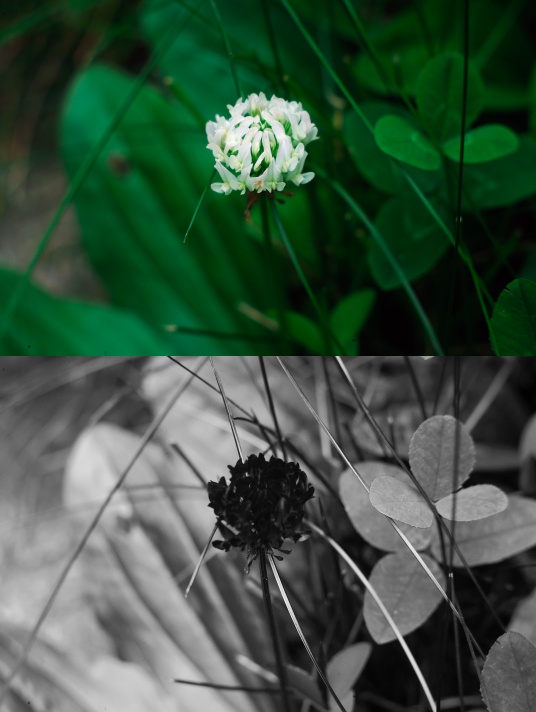
Fig. 30. Another surprising one is the common white clover flower, which reflects visible light but strongly absorbs UV, appearing pitch black in ultraviolet. Clover is also known as trefoil, named for the characteristic three leaves.
| Lens | Fused silica custom | Focus mode | Manual |
| Date | 06/22/2014 | Time | 07:44 pm |
| Shutter speed (top) | 1/20 sec | Shutter speed (bottom) | 20 sec |
| Aperture | f/7 | ISO | 200 |
| Focal length | 80 mm | Distance | 0.2 meters |
| Filter (top) | UV/IR block | Filter (bottom) | Baader U filter |
If viewing on a cell phone, drag table left or right to scroll.
Fig. 31 Ultraviolet photo of diet orange soda.
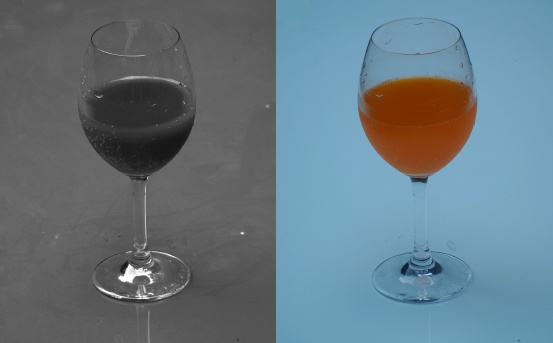
Fig. 31. Diet orange soda looks cloudy in the ultraviolet.
| Lens | Fused silica custom | Focus mode | Manual |
| Date | 07/29/2014 | Time | 07:28 am |
| Shutter speed (left) | 2 sec | Shutter speed (right) | 1/100 sec |
| Aperture | f/7 | ISO | 200 |
| Focal length | 80 mm | Distance | 1 meter |
| Filter (left) | Baader U filter | Filter (right) | UV/IR block |
If viewing on a cell phone, drag table left or right to scroll.
Fig. 32 Croissants.

Fig. 32. UV photo of croissants from the grocery store. All baked goods, typically light brown, appear black in the ultraviolet.
| Lens | Fused silica custom | Focus mode | Manual |
| Date | 07/29/2014 | Time | 07:30 am |
| Shutter speed | 2 sec | Aperture | f/7 |
| ISO | 200 | Focal length | 80 mm |
| Distance | 1 meter | Filter | Baader U filter |
If viewing on a cell phone, drag table left or right to scroll.
Fig. 33 Grapefruit.
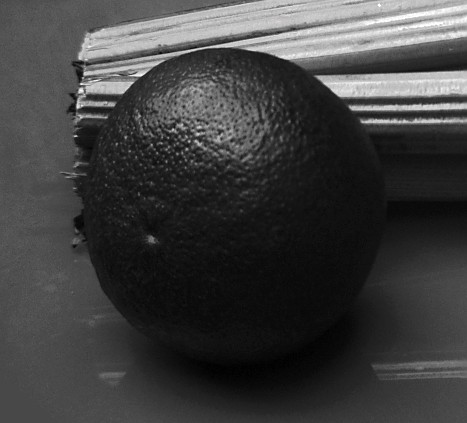
Fig. 33. UV photo of grapefruit and celery. Grapefruit appear black in UV, as do green tomatoes, but celery doesn't.
| Lens | Fused silica custom | Focus mode | Manual |
| Date | 07/29/2014 | Time | 07:17 am |
| Shutter speed | 1 sec | Aperture | f/7 |
| ISO | 200 | Focal length | 80 mm |
| Distance | 1 meter | Filter | Baader U filter |
If viewing on a cell phone, drag table left or right to scroll.
Fig. 34 Blue Iris.
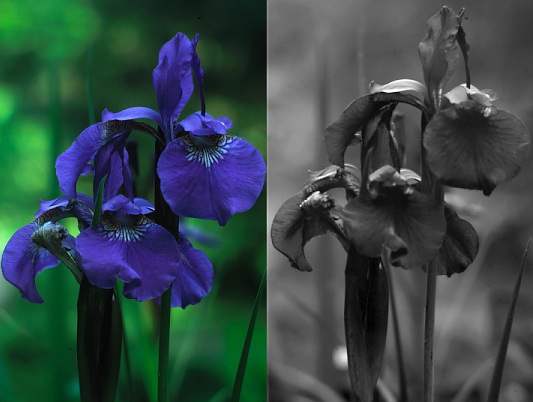
Fig. 34. This blue Siberian iris is not black in UV, but the white lines are no longer visible.
| Lens | Fused silica custom | Focus mode | Manual |
| Date | 05/28/2015 | Time | 18:47 |
| Shutter speed (left) | 1/100 sec | Shutter speed (right) | 1.6 sec |
| Aperture | f/7 | ISO | 200 |
| Focal length | 80 mm | Distance | 1.5 meters |
| Filter (left) | UV/IR Block | Filter (right) | Baader U filter |
If viewing on a cell phone, drag table left or right to scroll.
Fig. 35 White Caterpillar (Halysidota tessellaris).
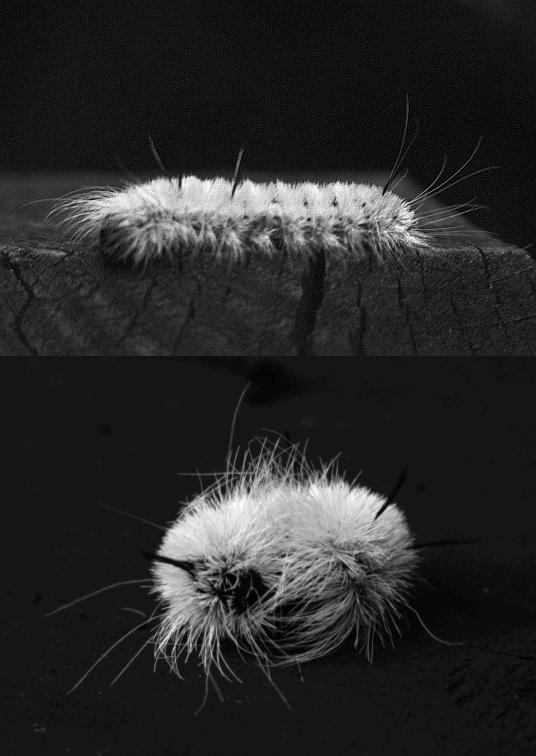
Fig. 35. This white caterpillar (banded tussock moth, Halysidota tessellaris) with black spikes and shiny black head looked exactly the same in ultraviolet, visible, and infrared (UV shown). The body is black and there are yellow spots on the head. The hairs act like whiskers. When the hairs contact a leaf, the caterpillar tries to climb up on it. But when it detects carbon dioxide, it curls up into a defensive ball, hides its head, and freezes. That doesn't prevent the camera from stealing its soul ... such as it is ....
| Lens | Fused silica custom | Focus mode | Manual |
| Date | 09/07/2015 | Aperture | f/7 |
| Shutter speed (top) | 1/10 sec | Shutter speed (bottom) | 2.0 sec |
| Time (top) | 13:12 | Time (bottom) | 09:07 |
| Focal length | 80 mm | Distance | 0.5 meters |
| Filter | Baader U Filter | ISO | Top:800, Bottom:400 |
If viewing on a cell phone, drag table left or right to scroll.
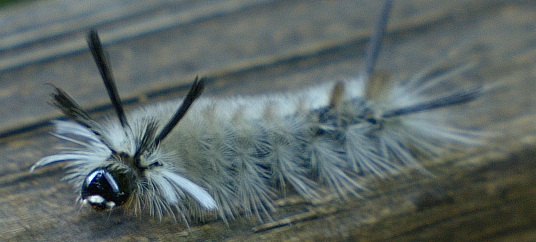
Visible light photo of a different specimen of Halysidota tessellaris larva showing the yellow spots on the front of the head. This one is smaller than the one above and has a brown tint on its hairs. (Fused silica lens, 1/13 sec, D7000, ISO 200, 09/07/2015 18:04)
References
[1]. Smith, WJ, Modern Optical Engineering, 4th ed., p.87.
Click here for more UV images.
